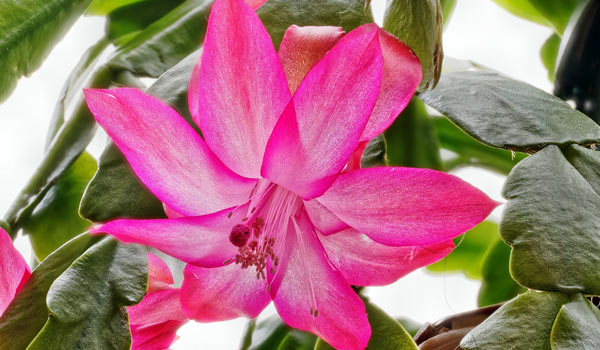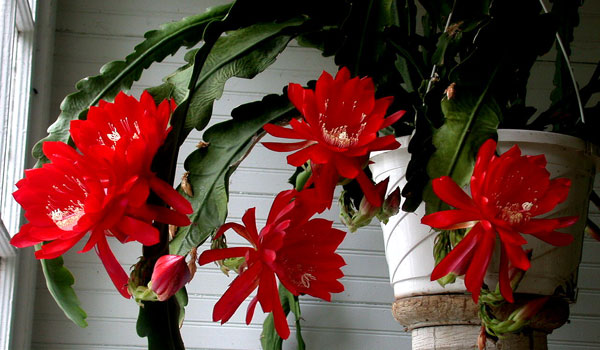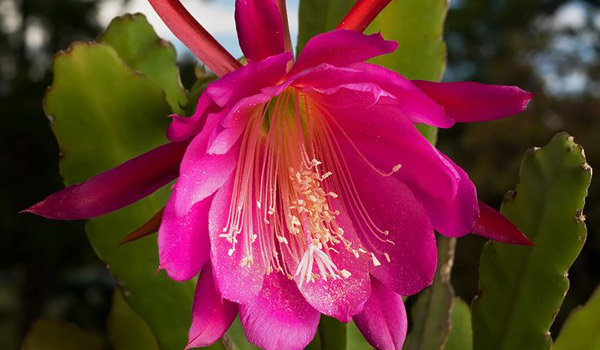Orchid Cactus Care Guide + Tips

Big flowers with vibrant colors make the orchid cactus a delightful plant to add to your succulent collection. With the proper, you’ll be able to enjoy waves of flowers for several weeks during the epiphyllum orchid cactus bloom time.
Growing this plant is an absolute joy. The only tricky part is watering it, which should be carefully balanced. In the following, you’ll find tips on orchid cactus care to have a healthy plant that amazes anyone with its flowers. But first, let’s know the cactus orchid better.

Epiphyllum Orchid Cactus
As evident by its name, this plant is an epiphytic cactus. Cactus orchid is native to tropical forests of Central and South America. It grows on other plants (mostly tree crotches and rotting vegetation), not as a parasite, but as a host; and lives off of organic wastes like leaf mold.
From early winter through spring, the orchid cactus blooms appear on the jointed stems (also known as leaves) crown and last only a couple of days but keep you company from early winter through spring. Although not cold-hardy, it blooms best when exposed to cool temperatures and short periods of light.
The flattened stems have two-edged or triangular shapes, and the overall size of this unique plant can reach up to 18 to 30 inches. In addition to eye-catching flowers, the epiphyllum orchid cactus produces edible fruits that have a texture similar to kiwi, and almost tastes like passion vine fruit.
Orchid Cactus Varieties
This plant has about 20 species ranging from free-flowering hybrids to miniature or basket varieties. Cactus orchid has a number of genera such as Epiphyllum, Rhipsalis, Selenicereus, and Disocactus.
It is easier to distinguish orchid cactus varieties by their blooms’ colors since it is the main difference in varieties (however, the shape of branch and flower are also different):
- Pink: Unforgettable, Millennium, Ophelia
- Purple: Dragon Fruit, Miss Hollywood
- Red: Arlene, Beautiful Red, Miss America
- Orange: Cutie, Dragon Heart, Hawaii
- Yellow: Jennifer Anne, King of Yellows, Desert Falcon
- White: French Sahara, Fred Bouton, College Queen

Orchid Cactus Care
This is a great plant for hanging baskets, and you can grow it indoors or outdoors. To have a healthy and happy plant, keep its requirements in mind:
Watering
During its growing season (early spring), your plant needs constant moisture, both in the air and for the roots, similar to other orchid cactus varieties.
In its rest period during the winter, it needs just enough water so its stems don’t shrivel. Let it dry off slightly during dormancy but never let the soil completely dries. This is the needed balance that we talked about.
Temperature & Humidity
The epiphyllum orchid cactus is practically a “shade plant” that is found in hot climates. In the tropical forests, they spend the summer in tree shades. But in the spring, fall and winter, they enjoy the sunlight. So you only need to protect them from the burning summer sun.
In the temperatures near 65° degrees Fahrenheit and the humid air, the orchid cactus blooms best. To provide the humidity that it needs as well as cleaning the dust, mist, or spray the stems when it isn’t in bud or flower.
Soil & Fertilizer
Unlike many other cacti and succulents, cactus potting soil mixes are not suitable for orchid cactus care. As we mentioned, this tropical plant is a tree-dweller that feeds on organic wastes and is largely exposed to the air.
So, it is better to provide your epiphyllum orchid cactus with a light, well-draining, slightly acidic, and rich potting mix. A type of mix that maintains some moisture but drains the excess water quickly. For better aeration and purification, adding small bits of crushed charcoal would be an excellent idea.
Using fertilizer is recommended in orchid cactus care. For feeding, wait until the plant’s growth begins (In February). Then you can feed it with weak liquid foliar cactus fertilizer solutions every two weeks. Stop when the growth period is over, and don’t use Nitrogen-rich fertilizers.
Pruning & Repotting
Pruning is only necessary for orchid cactus care when you want to control its size. The best time for pruning it is shortly after the orchid cactus bloom time is over. Therefore, never repot while it’s producing flowers. This will cause the buds and blooms to drop.
To avoid tearing the stems, trim with sharp, clean pruning shears. You can use these cutting later for orchid cactus propagation.
Every 2 or 3 years, you can repot the plant to the next size pot or into hanging baskets. This plant likes to be slightly pot-bound and blooms best this way. But if it is badly pot-bound, don’t hesitate to repot.

Encouraging Orchid Cactus to Bloom
If you provide the condition that this unique plant needs, it will flower with no problem. However, there are the things that you need to make sure of to help:
- The epiphyllum needs a cool, dry rest for 8 to 10 weeks in winter to set buds. During this time, water sparingly and don’t fertilize.
- Place your cactus orchid in a bright spot with indirect light. In case you moved it outdoors in the summer, be sure to keep it shaded. Also keep it away from drafty areas (heat/AC vents or doorways).
- High-phosphorus fertilizer will encourage more orchid cactus blooms. Fertilize through early spring and fall.
Last but not least, when you noticed buds, don’t change the plant’s location. When you move it around, the cactus orchid will find itself in a new condition with different light and temperatures, resulting in the falling of the buds and flowers.
Orchid Cactus Problems
Overwatering is responsible for most of the orchid cactus problems. If your plant sits in water, the stems will turn limp or darken at the base (also known as stem rot). If you notice this problem see stem rot, cut back the watering. Also, remove the blackened stems at the soil level.
Overwatering can also lead to fungus gnats infestations on the stems. Other potential pests that can bother your epiphyllum orchid cactus include aphids, mealybugs, and spider mites. You can treat such conditions with insecticide soap or Neem oil. To prevent this problem in the future, water away from stems and use well-draining soil mixes.
Other orchid cactus problems include a sunburned appearance and yellow or wilted stems, which indicates overexposure to very hot and direct light. On the other hand, if your epiphyllum doesn’t get enough sunlight, it’ll seem leggy and weak.
How to Propagate Orchid Cactus
For orchid cactus propagation, simply follow these steps:
- In the spring, cut off a 4 to 6-inch stem.
- Allow it to callous for a few days in a dark and cool place.
- Place the cut end upright in lightly moist potting mix.
- Keep cuttings at room temperature (65 to 75 °F).
After about 4 to 6 weeks, you’ll see the roots. Now you can treat your young plant as it is a mature one. Remember that in order to bloom, you need to wait until the roots are snug against one another and gain security. This is the same thing that happens in nature; the epiphyllum orchid cactus attaches to tree bark, its roots wrap tightly around the tree, and secures it in its place.
- In this post:
- Epiphyllum Orchid Cactus
- Orchid Cactus Varieties
- Orchid Cactus Care
- Encouraging Orchid Cactus to Bloom
- Orchid Cactus Problems
- How to Propagate Orchid Cactus



